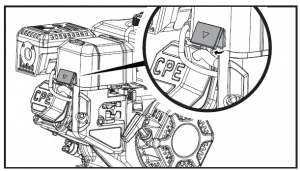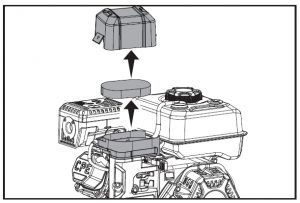CHAMPION POWER EQUIPMENT 224cc Engine Instruction Manual
 READ AND SAVE THIS MANUAL.This manual contains important safety precautions which should be read and understood before operating the product. Failure todo so could result in serious injury. This manual should remain with the product. Specifications, descriptions and illustrations in this manual are as accurate as known at the time of publication, but are subject to change without notice.
READ AND SAVE THIS MANUAL.This manual contains important safety precautions which should be read and understood before operating the product. Failure todo so could result in serious injury. This manual should remain with the product. Specifications, descriptions and illustrations in this manual are as accurate as known at the time of publication, but are subject to change without notice.
INTRODUCTION
Congratulations on your purchase of a Champion Power Equipment (CPE) product. CPE designs, builds, and supports all of our products to strict specifications and guidelines. With proper product knowledge, safe use, and regular maintenance, this product should bring years of satisfying service. Every effort has been made to ensure the accuracy and completeness of the information in this manual at the time of publication, and we reserve the right to change, alter and/or improve the product and this document at any time without prior notice.
CPE highly values how our products are designed, manufactured, operated, and serviced as well as providing safety to the operator and those around the engine. Therefore, it is IMPORTANT to review this product manual and other product materials thoroughly and be fully aware and knowledgeable of the assembly, operation, dangers and maintenance of the product before use. Fully familiarize yourself, and make sure others who plan on operating he product fully familiarize themselves too, with the proper vsafety and operation procedures before each use. Please always exercise common sense and always err on the side of caution when operating the product to ensure no accident, property damage, or injury occurs. We want you to continue to use and be satisfied with your CPE product for years to come. When contacting CPE about parts and/or service, you will need to supply the complete model and serial numbers of your product. Transcribe the information found on your product’s nameplatelabel to the table below
SAFETY DEFINITIONS
The purpose of safety symbols is to attract your attention to possible dangers. The safety symbols, and their explanations, deserve your careful attention and understanding. The safety warnings do not by themselves eliminate any danger. The instructions or warnings they give are not substitutes for proper accident prevention measures.
 DANGER indicates a hazardous situation which,if not avoided, will result in death or serious injury.
DANGER indicates a hazardous situation which,if not avoided, will result in death or serious injury. WARNING indicates a hazardous situation which, if not avoided, could result in death or serious injury.
WARNING indicates a hazardous situation which, if not avoided, could result in death or serious injury. CAUTION indicates a hazardous situation which, if not avoided, could result in minor or moderate injury.
CAUTION indicates a hazardous situation which, if not avoided, could result in minor or moderate injury.
IMPORTANT SAFETY INSTRUCTIONS
WARNINGCancer and Reproductive Harm – www.P65Warnings.ca.gov
DANGEREngine exhaust contains carbon monoxide, a colorless, odorless, poisonous gas. Breathing carbon monoxide will cause nausea, dizziness, fainting or death. If you start to feeldizzy or weak, get to fresh air immediately.
OPERATE ENGINE OUTDOORS ONLY IN A WELL VENTILATED AREA AND POINT EXHA UST AWAY.
DO NOT operate the engine inside any building, including garages, basements, crawlspaces, sheds or enclosed compartments.DO NOT allow exhaust fumes to enter a confined area through windows, doors, vents or other openings.
DANGERUsing an engine indoors CAN KILL YOU IN MINUTES. Engine exhaust contains carbon monoxide. This is a poison you cannot see or smell
NEVER use inside a home or garage, EVEN IF doors and windows are open.ONLY use OUTSIDE and far away from windows, doors, and vents.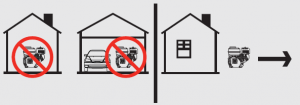
Install battery-operated carbon monoxide alarms or plug-in carbon monoxide alarms with battery back-up according to themanufacturer’s instructions.
DANGEROperate equipment with guards in place. Rotating parts can entangle hands, feet, hair, clothing and/or accessories. Traumatic amputation or severe laceration can result.
Keep hands and feet away from rotating parts. Tie up long hair and remove jewelry.DO NOT wear loose-fitting clothing, dangling drawstrings or items that could become caught.
WARNINGOperation of this equipment may create sparks that can start fires around dry vegetation.A spark arrestor may be required. The operator should contact local fire agencies for laws or regulations relating to fire prevention requirements.
WARNINGSparks can result in fire or electrical shock. When servicing the engine: Disconnect the spark plug wire and place it where it cannot contact the plug.DO NOT check for spark with the plug removed. Use only approved spark plug testers.
WARNINGRunning engines produce heat. Severe burns can occur on contact. Combustible material can catch fire on contact.DO NOT touch hot surfaces. Avoid contact with hot exhaust gases. Allow equipment to cool before touching. Maintain at least 3 ft. (91.4 cm) of clearance on all sides toensure adequate cooling. Maintain at least 5 ft. (1.5 m) of clearance from combustible materials.
WARNING
Rapid retraction of the recoil cord will pull hand and arm towards the engine faster than you can let go. Broken bones, fractures, bruises or sprains could result. Unintentional startup can result in entanglement, traumatic amputation or laceration.When starting engine, pull the recoil cord slowly until resistance is felt and then pull rapidly to avoid kickback.DO NOT start or stop the engine with electrical devices plugged in and turned on.
Fuel Safety
DANGERGASOLINE AND GASOLINE VAPORS ARE HIGHLY FLAMMA BLE AND EXPLOSIVE.Fire or explosion can cause severe burns or death.
Gasoline and gasoline vapors:
– Gasoline is highly flammable and explosive.– Gasoline can cause a fire or explosion if ignited.– Gasoline is a liquid fuel but it’s vapors can ignite.– Gasoline is a skin irritant and needs to be cleaned up immediately if spilled on skin or clothes.– Gasoline has a distinctive odor, this will help detect potential leaks quickly.– Gasoline expands or contracts with ambient temperatures. Never fill the gasoline tank to full capacity, as gasoline needs room to expand when temperatures rise.– In the case of any petroleum gasoline fire, flames should never be extinguished unless the fuel supply valve can be turned OFF. By not doing so, if a fire is extinguished and the supply of fuel is not turned OFF, an explosion hazard could be created.
When adding or removing gasoline:
DO NOT light or smoke cigarettes. Turn the engine off and let cool for at least two minutes before removing the gasoline cap. Always loosen the cap slowly to relievepressure in the tank. Only fill or drain gasoline outdoors in a well-ventilated area. DO NOT pump gasoline directly into the engine at the gas station. Always use an approved container to transfer the fuel to the engine. DO NOT overfill the gasoline tank. Always keep gasoline away from sparks, open flames, pilot lights, heat and other sources of ignition.
DANGER
NEVER place a gasoline container, gasoline tank or any combustible material in the path of the exhaust stream during operation of the engine.
WARNING
Never use a gasoline container, gasoline tank, or any other fuel item that is broken, cut, torn or damaged.
Safety and Dataplate Labels
These labels warn you of potential hazards that can cause serious injury. Read them carefully. If a label comes off or becomes hard to read, contact Technical Support Team for possible replacement.
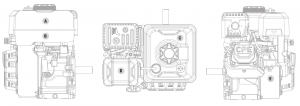 Side Top Muffler
Side Top Muffler
LABEL |
DESCRIPTION |
|
| A | 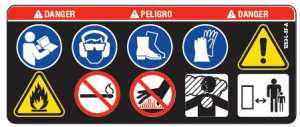 |
Safety Symbols |
| B | 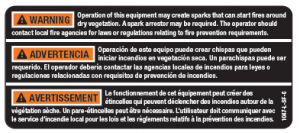 |
Spark Arrestor |
| C |  |
Fuel Safety |
| D | 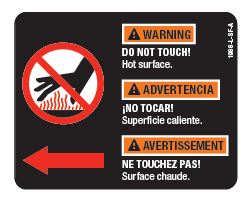 |
Hot Surface |
| E | 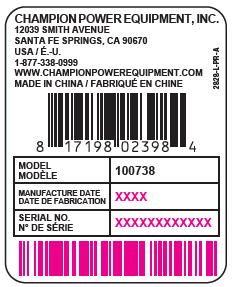 |
Dataplate |
Safety Symbols
SYMBOL MEANING |
|
 |
Read Operator’s Manual. To reduce the risk of injury, user must read and understand operator’smanual before using this product |
 |
Eye and Ear Protection. Always wear safety goggles or safety glasses with side shields, and asnecessary a full face-shield as well as full ear protection when operating this product. |
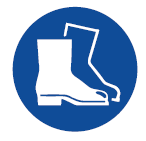 |
Footwear. Always wear safety shoes or heavy boots when operating the machine. |
 |
Gloves. Always wear nonslip, heavy-duty protective gloves when operating this product. |
 |
Safety Alert. Precautions that involve your safety |
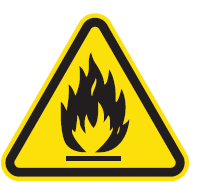 |
Risk of Fire. Fuel and its vapors are extremely flammable and explosive. Fire can cause severeburns or death. Do not add fuel while the product is operating or still hot. |
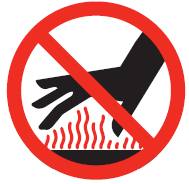 |
Hot Surface. To reduce the risk of injury or damage, avoid contact with any hot surface |
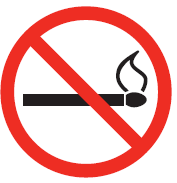 |
Open Flame alert. Fuel and its vapors are extremely flammable and explosive. Keep fuel awayfrom smoking, open flames, sparks, pilot lights, heat, and other ignition sources. |
SYMBOL MEANING |
|
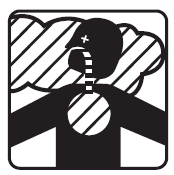 |
Toxic Fumes. The engine exhaust from this product contains chemicals known to the state of California to cause cancer and birth defects and other reproductive harm. Risk of Asphyxiation. This engine emits carbon monoxide, an odorless, colorless poison gas.Breathing carbon monoxide can cause nausea, fainting or death. Use only in a well ventilatedarea. |
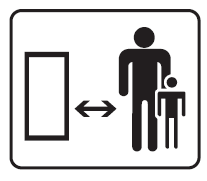 |
Clearance. Keep all objects including others at least 10 feet (3m) from this machine. |
Operation Symbols
Some of the following symbols may be used on this product. Please study them and learn their meaning. Proper interpretation of thesesymbols will allow you to more safely operate the product.
SYMBOL MEANING |
|
 |
STOP or OFF |
 |
Fuel/Gasoline Valve ON/OFF |
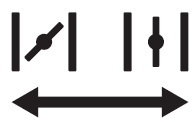 |
Choke LeverCHOKE: left position RUN: right position |
SYMBOL MEANING |
|
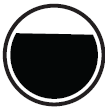 |
Fuel Gauge: Full |
|
|
Fuel Gauge: Empty |
 |
Throttle Lever FAST/SLOW |
Quickstart Label Symbols
Some of the following symbols may be used on this product. Please study them and learn their meaning. Proper interpretation of these symbols will allow you to more safely operate the product.
Starting the Engine
DANGERMove equipment outside and far away from windows, doors and intake ventilation covers.
- Check oil level. Recommended oil is 5W-30.
- Check gasoline level. When adding gasoline, use a minimum octane rating of 87 and an ethanol content of 10% or less by volume.
- Move the choke lever to “CHOKE” position.
- Move the throttle lever to “FAST” position.
- Turn the fuel valve to “ON” position.
- Pull the recoil cord.
- Move the choke lever to “RUN” position.
Stopping Engine
In an emergency, turn the engine switch to the “OFF” position.Under normal operation:
- Turn the fuel valve to the “OFF” position.
- Let the engine run until fuel starvation has stopped the engine. This usually takes few minutes.Important: Always ensure that the fuel valve is in the “OFF” position when the engine is not in use.
CONTROLS AND FEATURES
Read this operator’s manual before operating your log splitter. Familiarize yourself with the location and function of the controls andfeatures. Save this manual for future reference.
Engine

- Muffler
- Air Filter – Protects the engine by filtering dust and debris from the intake air.
- Throttle Control
- Choke – Used to start the engine.
- Fuel Valve On/Off
- Oil Fill Cap/Dipstick – Used to check and fill oil level.
- Oil Drain Bolt – Used to drain engine oil.
- Recoil Starter – Used to manually start the engine.
- Engine Switch – Used to stop the engine.
- Gasoline Tank – 0.8 gal. (3.1 L)
- Gasoline Gauge
- Fuel Cap – Remove to add fuel.
ASSEMBLY
Add Engine Oil
WARNINGDO NOT attempt to crank or start the engine before it has been properly filled with the recommended type and amount of oil. Damage to the engine as a result of failing to follow these instructions will void your warranty.
NOTICEThe recommended oil type for typical use is 5W-30 automotive oil. However, using the listed conventional oils shown in the “Recommended Engine Oil Type” chart may be used for typical use including the first 5 hours of the break-in run time period of the engine. If running engine in extreme temperatures, refer to the “Recommended Engine Oil Type” chart.
- Place the equipment on a flat, level surface.
- Remove oil fill cap/dipstick to add oil.
- Using a funnel, add up to 16.9 fl. oz (500 ml) (include) of oil and replace oil fill cap/dipstick. DO NOT OVERFILL.

- Check engine oil level daily and add as needed.

NOTICEOnce oil has been added, a visual check should show oil about 1-2 threads from running out of the fill hole. If using the dipstick to check oil level, DO NOT screw in thedipstick while checking.
NOTICECheck oil often during the break-in period. Refer to the Maintenance section for recommended service intervals.
CAUTIONThe engine is equipped with a low oil shut-off and will stop when the oil level in the crankcase falls below the threshold level.
NOTICEThe first 5 hours of run time are the break-in period for the unit. During the break in period stay at or below 50% of the running watt rating and vary the load occasionally to allow stator windings to heat and cool. Adjusting the load will also cause engine speed to vary slightly and help seat piston rings. After the 5 hour break-in period, change the oil.
NOTICESynthetic oil may be used after the 5 hour initial break-in period. Using synthetic oil does not decrease the recommended oil change interval. Full synthetic 5W-30 oil will aid in starting in cold ambient < 41º F (5º C) temperatures
Add Fuel
- Use clean, fresh, regular unleaded gasoline with a minimum octane rating of 87 and an ethanol content of less than 10% by volume. ybc
- DO NOT mix oil with gasoline.
- Remove the gasoline cap.
- Slowly add gasoline to the tank. DO NOT OVERFILL. Gasoline can expand after filling. A minimum of ¼ in. (6.4 mm) of space left in the tank is required for gasolineexpansion, although more than ¼ in. (6.4 mm) is recommended. Gasoline can be forced out of the tank as a result of expansion if overfilled, and can affect the stablerunning condition of the log splitter.

- The approximate fuel level is shown on the fuel gauge on top of the fuel tank.

CAUTIONUse unleaded gasoline with a minimum octane rating of 87 and an ethanol content of 10% or less by volume.DO NOT light cigarettes or smoke when filling the tank.DO NOT mix oil and gasoline.DO NOT overfill the tank. Fill tank to approximately ¼ in. (6.4 mm) below the top of the tank to allow for gasoline expansion.DO NOT pump gasoline directly into the engine at the pump. Use an approved fuel container to transfer the gasoline to the engine.DO NOT fill tank indoors.DO NOT fill tank when the engine is running or hot.
WARNINGPouring gasoline too fast through the fuel screen may result in blow back of gasoline at the operator while filling.
NOTICEThe engine works well with 10% or less ethanol blended gasoline. When using ethanol-gasoline blends there are some issues worth noting:– Ethanol-gasoline blends can absorb more water than gasoline alone.– These ethanol blends can eventually separate, leaving water or a watery goo in the tank, fuel valve and carburetor. The compromised gasoline can be drawn into the carburetor and cause damage to the engine and/or create potential hazards.– If a fuel stabilizer is used, confirm that it is formulated to work with ethanol-gasoline blends.– Any damages or hazards caused by using ethanol blended gasoline higher than 10% by volume, improperly stored gasoline, and/or improperly formulated stabilizers, are notcovered by manufacturer’s warranty. It is advisable to always shut off the gasoline supply and run the engine to starvation after each use. See Storage instructions for extended non-use.
OPERATION
Starting the Engine
- Make certain the equipment is on a flat, level surface.
- Move the choke lever to the “CHOKE” position

- Move the throttle lever to “FAST” position

- Move the fuel valve to the “ON” position

- Pull the starter cord until resistance is felt and then pull rapidly.

- As engine warms up, move the choke lever to the “RUN” position.NOTICEKeep choke lever in “Choke” position for 2 pulls of the recoil starter. After second pull, move choke lever to the “Run” position for up to the next 3 pulls of the recoil starter. Too much choke leads to spark plug fouling/engine flooding due to the lack of incoming air. This will cause the engine not to start.
 NOTICEIf the engine starts but does not run make certain that the log splitter is on a flat, level surface. The engine is equipped with a low oil sensor that will prevent the engine from running when the oil level falls below a critical threshold.
NOTICEIf the engine starts but does not run make certain that the log splitter is on a flat, level surface. The engine is equipped with a low oil sensor that will prevent the engine from running when the oil level falls below a critical threshold.
Stopping the Engine
In an emergency, turn the engine switch to the “OFF” position.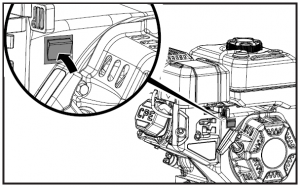
Under normal operation:
- Turn the fuel valve to the “OFF” position.

- Let the engine run until fuel starvation has stopped the engine. This usually takes few minutes. Important: Always ensure that the fuel valve is in the “OFF” position when the engine is not in use.
NOTICE
If the engine will not be used for a period of two (2) weeks or longer, please see the Storage section for proper engine and fuel storage.
Operation at High Altitude
The density of air at high altitude is lower than at sea level. Engine power is reduced as the air mass and air-fuel ratio decrease. Engine power and equipment output will be reduced approximately 3½% for every 1000 ft. of elevation above sea level. This is a natural trend and cannot be changed by adjusting the engine. At high altitudes increased exhaust emissions can also result due to the increased enrichment of the air fuel ratio. Other high altitude issues can include hard starting, increased fuel consumption and spark plug fouling. To alleviate high altitude issues other than the natural power loss, CPE can provide a high altitude carburetor main jet. The alternative main jet and installation instructions can be obtained by contacting our Technical Support Team. Installation instructions are also available in the Technical Bulletin area of the CPE website. The part number and recommended minimum altitude for the application of the high altitude carburetor main jet is listed in the table below. In order to select the correct high altitude main jet it is necessary to identify the carburetor model. For this purpose, a code is stamped on the side of the carburetor. Select the correct high altitude jet part number corresponding to the carburetor code found on your particular carburetor.
Carb. Code High Alt. Jet Part Number Min. Altitude |
||
| 16100-Z811411-00M3 | 16161-Z152010-00A3 | Standard |
| 16161-Z151810-00A2 | 3000-6000 ft.(914.4-1828.8 m) | |
| 6161-Z151610-00A6 | 6000-8000 ft.(1828.8-2438.4 m) |
WARNINGOperation using the alternative main jet at elevations lower than the recommended minimum altitude can damage the engine. For operation at lower elevations, the originallysupplied standard main jet must be used. Operating the engine with the wrong engine configuration at a given altitude may increase its emissions and decrease fuel efficiency and performance.
MAINTENANCE
Make certain that the engine is kept clean and stored properly. Only operate the unit on a flat, level surface in a clean, dry operating environment. DO NOT expose the unit to extreme conditions, excessive dust, dirt, moisture or corrosive vapors. Inspect all air vents and cooling slots to ensure that they are clean and unobstructed.Clean spark arrester every 100 hours. Check and tighten all bolts and nuts before operating the engine.
WARNINGNever operate a damaged or defective engine.
WARNINGImproper maintenance will void your warranty.
NOTICEFor Emission control devices and systems, read and understand your responsibilities for service as stated in the Emission Control Warranty Statement of this manual.
The owner/operator is responsible for all periodic maintenance. Complete all scheduled maintenance in a timely manner. Correct any issue before operating the engine.For service or parts assistance, contact our Technical Support Team at 1-877-338-099
Cleaning the Engine
CAUTIONDO NOT spray engine with water. Water can contaminate the fuel system and can enter the engine through the cooling slots and damage the engine.Use a damp cloth to clean exterior surfaces of the engine. Use a soft bristle brush to remove excess dirt and oil. Use an air compressor (25 PSI) to clear dirt and small debris.
Changing the Engine Oil
Change oil when the engine is warm. Refer to the oil specification to select the proper grade for your operating environment.
- Remove the oil drain plug with a 10 mm socket (not included) and extension.

- Allow the oil to drain completely into an appropriate container.
- Replace the oil drain plug.
- Remove the oil fill cap/dipstick to add oil.
- Add oil according to Add Engine Oil in Assembly section. DO NOT OVERFILL. Oil not included for routine maintenance.
- Dispose of used oil at an approved waste management facility.
NOTICE
Once oil has been added, a visual check should show oil about 1-2 threads from running out of the fill hole. If using the dipstick to check oil level, DO NOT screw in the dipstick while checking.
Cleaning and Adjusting the Spark Plug(s)
- Remove the spark plug cable from the spark plug.
- Use a spark plug socket tool (not included), or a 13/16 in. (21 mm) socket (not included) to remove the plug.
- Inspect the electrode on the plug. It must be clean and not worn to produce the spark required for ignition.
- Make certain the spark plug gap is 0.028-0.031 in. (0.7-0.8 mm).

- 5Refer to the spark plug types in Specifications when replacing the plug.
- Firmly re-install the plug.
- Attach the spark plug cable to the spark plug.
Cleaning the Air Filter
- Using your finger, pry the outer tab up slightly and lift the air filter cover above the tab lock position.

- Remove both air filter cover and air filter element.

- Wash in liquid detergent and water. Squeeze thoroughly dry ina clean cloth.
- Saturate in clean engine oil.
- Squeeze in a clean, absorbent cloth to remove all excess oil.
- Place the filter in the assembly.
- Reattach the air filter cover. Attach the side closest to the gas tank then pivot down to close. Make sure air filter cover snaps in place.
Maintenance Schedule
Follow the service intervals indicated in the following maintenance schedule.Service your engine more frequently when operating in adverse conditions.Contact our Technical Support Team at 1-877-338-0999 to locate the nearest CPE certified service dealer for your log splitter or engine maintenance needs.
EVERY 8 HOURS OR DAILY
Check engine oil level Clean around air intake and muffler
FIRST 5 HOURS
Change oil
EVERY 50 HOURS OR EVERY SEASON
Clean air filter Change oil if operating under heavy load or in hot environments
EVERY 100 HOURS OR EVERY SEASON
Change oil Clean/adjust spark plug Check/adjust valve clearance* Clean spark arrestor Clean fuel tank and filter*
EVERY 250 HOURS
Clean combustion chamber*
EVERY 3 YEARS
Replace fuel line** To be performed by knowledgeable, experienced owners or CPE certified service centers.
STORAGE
Refer to the Maintenance section for proper cleaning instructions.
Engine Storage
- The engine needs to be cool for at least 5 minutes before storing.
- Clean the engine before storage according to the Maintenance section.
Engine Stored for Less than 30 Days
- Allow the engine to cool completely before storage.
- Clean engine according to the Maintenance section.
- To extend the fuel storage life add a properly formulated fuel stabilizer to the tank.
- Ensure the fuel valve is in the “OFF” position.
Engines Stored for Over 30 Days
- Add a properly formulated fuel stabilizer to the tank.
- Run the engine for a few minutes so the treated fuel cycles through the fuel system and carburetor.
- Turn the fuel valve to the “Off” position.
- Let the engine run until fuel starvation has stopped the engine. This usually takes a few minutes.
- The engine needs to cool completely before cleaning and storage.
- Clean the engine according to the Maintenance section.
- Change the oil.
- Remove the spark plug and pour about 14.8 mL (1⁄2 ounce) of oil into the cylinder. Using the Recoil, crank the engine slowly to distribute the oil and lubricate the cylinder.
- Reattach the spark plug.
WARNING
Never store the engine indoors next to appliances where there is a source of heat or open flame, spark or pilot light because they can ignite gasoline vapors.DO NOT store engine near fertilizer or any corrosive material. Even with an empty gas tank, gasoline vapors could ignite.
Oil Specifications
DO NOT OVERFILL
Type.. . . . . . . . . . . . . . . . . . . . . . . . . . . See chart belowCapacity.. . . . . . . . . . . . . . . . . . . . . . . . 16.9 fl. oz (500 ml)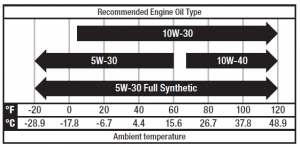
NOTICE
Temperature will affect engine oil and engine performance. Change the type of engine oil used based on temperature shown in the “Recommended Engine Oil Type” table.
Fuel Specifications
Use unleaded gasoline with a minimum octane rating of 87 and an ethanol content of 10% or less by volume. DO NOT USE E15 orE85. DO NOT OVERFILLGasoline Capacity.. . . . . . . . . . . . . . . . . .0.8 gal. (3.1 L)
Spark Plug Specifications
OEM Type.. . . . . . . . . . . . . . . . . . . . .NHSP F6RTCReplacement Type.. . . . . . . . . . . . . . .NGK BPR6ES or equivalentGap.. . . . . . . . . . . . . . . . . . . . . . . . . . 0.028-0.031 in. (0.7-0.8 mm)
Valve Specifications
Intake Clearance.. . . . . . . . . . . . 0.0039-0.0059 in. (0.10-0.15 mm)Exhaust Clearance.. . . . . . . . . . . 0.0059-0.0079 in. (0.15-0.20 mm)
NOTICEA technical bulletin regarding valve adjustment procedures is available at www.championpowerequipment.com.
Key Shaft

NOTICE
An important message about temperature: Your product is designed and rated for continuous operation at ambient temperatures up to 104°F (40°C). When needed, it may beoperated at temperatures ranging from 5°F (-15°C) to 122°F (50°C) for short periods of time. If exposed to temperatures outside this range during storage, it should be brought back within this range before operation. In any event, the product must always be operated outdoors, in a well-ventilated area and away from doors, windows and vents.
TROUBLESHOOTING
Problem |
Cause |
Solution |
| Engine will not start. | No fuel. | Add fuel |
| Faulty spark plug. | Replace spark plug. | |
| Unit loaded during start up. | Remove load from unit. | |
| Engine will not start;Engine starts but runs roughly | Low oil level. | Fill crankcase to the proper level. |
| Place log splitter on a flat, level surface. | ||
| Choke in the wrong position. | Adjust choke. | |
| Engine shuts down during operation. | Spark plug wire loose. | Attach wire to spark plug. |
| Out of fuel. | Fill fuel tank. | |
| Engine cannot supply enough power oroverheating. | Low oil level. | Fill crankcase to the proper level. Place logsplitter on a flat, level surface. |
| Engine gallops | Insufficient ventilation. | Check for air restriction. Move to a wellventilated area. |
| Engine governor defective | Contact technical support team |
For further technical support:
Technical Support TeamToll Free 1-877-338-0999
WARRANTY*
CHAMPION POWER EQUIPMENT2 YEAR LIMITED WARRANTY
Warranty Qualifications
To register your product for warranty and FREE lifetime call center technical support please visit:https://www.championpowerequipment.com/register To complete registration you will need to include a copy of the purchase receipt as proof of original purchase. Proof of purchase is required for warranty service. Please register within ten (10) days from date of purchase.
Repair/Replacement Warranty
CPE warrants to the original purchaser that the mechanical and electrical components will be free of defects in material and workmanship for a period of two years (parts and labor) from the original date of purchase and 180 days (parts and labor) for commercial and industrial use. Transportation charges on product submitted for repair or replacement under this warranty are the sole responsibility of the purchaser. This warranty only applies to the original purchaser and is not transferable.
Do Not Return The Unit To The Place Of Purchase
Contact CPE’s Technical Service and CPE will troubleshoot any issue via phone or e-mail. If the problem is not corrected by this method, CPE will, at its option, authorize evaluation, repair or replacement of the defective part or component at a CPE Service Center. CPE will provide you with a case number for warranty service. Please keep it for future reference. Repairs or replacements without prior authorization, or at an unauthorized repair facility, will not be covered by this warranty.
Warranty Exclusions
This warranty does not cover the following repairs and equipment:
Normal Wear
Products with mechanical and electrical components need periodic parts and service to perform well. This warranty does not cover repair when normal use has exhausted the life of a part or the equipment as a whole. Installation, Use and Maintenance This warranty will not apply to parts and/or labor if the product is deemed to have been misused, neglected, involved in an accident, abused, loaded beyond the product’s limits, modified, installed improperly or connected incorrectly to any electrical component. Normal maintenance is not covered by this warranty and is not required to be performed at a facility or by a person authorized by
Other Exclusions
This warranty excludes:– Cosmetic defects such as paint, decals, etc.– Wear items such as filter elements, o-rings, etc.– Accessory parts such as starting batteries, and storage covers.– Failures due to acts of God and other force majeure events beyond the manufacturer’s control.– Problems caused by parts that are not original Champion Power Equipment parts. When applicable, this warranty does not apply to products used for prime power in place of a utility.
Limits of Implied Warranty and Consequential Damage
Champion Power Equipment disclaims any obligation to cover any loss of time, use of this product, freight, or any incidental or consequential claim by anyone from using this product.THIS WARRANTY AND THE ATTACHED U.S. EPA and/or CARB EMISSION CONTROL SYSTEM WARRANTIES (WHEN APPLICABLE) ARE IN LIEU OF ALL OTHER WARRANTIES, EXPRESS OR IMPLIED, INCLUDING WARRANTIES OF MERCHANTABILITY OR FITNESS FOR A PARTICULAR PURPOSE.A unit provided as an exchange will be subject to the warranty of the original unit. The length of the warranty governing the exchanged unit will remain calculated by reference to the purchase date of the original unit. This warranty gives you certain legal rights which may change from state to state or province to province. Your state or province may also have other rights you may be entitled to that are not listed within this warranty.
Contact Information
AddressChampion Power Equipment, Inc.12039 Smith Ave.Santa Fe Springs, CA 90670 USAwww.championpowerequipment.comCustomer ServiceToll Free: 1-877-338-0999Fax no.: 1-562-236-9429Technical ServiceToll Free: 1-877-338-099924/7 Tech Support: 1-562-204-1188
CPE.*Except as otherwise stipulated in any of the following enclosed Emission Control System Warranties (when applicable) for the Emission Control System: U.S. Environment Protection Agency (EPA) and/or California Air Resources Board (CARB).
YOUR WARRANTY RIGHTS AND OBLIGATIONS:
The US EPA and CPE are pleased to explain the Federal Emission Control Systems Warranty on your 2021 small off-road engine (SORE) and engine powered equipment. New engines and equipment must be designed, built and equipped, at the time of sale, to meet U.S. EPA regulations for small off-road engines (SORE). CPE warrants the emission control system on your small off-road engine (SORE) and equipment for the period of time listed below, provided there has been no abuse, neglect, unapproved modification, or improper maintenance of your equipment. Your emission control system may include parts such as the carburetor, fuel-injection system, the ignition system, catalytic converter and fuel lines. Also included may be hoses, belts, connectors and other emission related assemblies. Where a warrantable condition exits, CPE will repair your small off-road engine (SORE) at no cost to you including diagnosis, parts and labor.
MANUFACTURER’S EMISSION CONTROL SYSTEM WARRANTY COVERAGE:
This emission control system is warranted for two years, subject to provisions set forth below. If, during the warranty period, an emission related part on your engine is defective in materials or workmanship, the part will be repaired or replaced by CPE.
OWNER WARRANTY RESPONSIBILITIES:
As the small off-road engine (SORE) owner, you are responsible for the performance of the required maintenance listed in your Owner’s Manual. CPE recommends that you retain all your receipts covering maintenance on your small off-road engine, but CPE cannot deny warranty solely for the lack of receipts or for your failure to ensure the performance of all scheduled maintenance. As the small off-road engine (SORE) owner, you should however be aware that CPE may deny you warranty coverage if your small, off-road engine (SORE) or a part has failed due to abuse, neglect, improper maintenance or unapproved modifications. You are responsible for presenting your small off-road engine (SORE) to an Authorized CPE service outlet or alternate service outlet as described in (3)(f.) below, CPE dealer or CPE, Santa Fe Springs, Ca. as soon as a problem exists. The warranty repairs should be completed in a reasonable amount of time, not to exceed 30 days. If you have any questions regarding your warranty rights and responsibilities, you should contact:
EMISSION CONTROL SYSTEM WARRANTY
The following are specific provisions relative to your Emission Control System (ECS) Warranty Coverage.
- APPLICABILITY: This warranty shall apply to 1997 and later model year small off-road engines (SORE). The ECS Warranty Period shall begin on the date the new engine or equipment is delivered to its original, end-use purchaser, and shall continue for 24 consecutive months thereafter.
- GENERAL EMISSIONS WARRANTY COVERAGECPE warrants to the original, end-use purchaser of the new engine or equipment and to each subsequent purchaser that each of its small off-road engines (SORE) is:2a. Designed, built and equipped so as to conform to U.S. EPA emissions standards for spark-ignited engines at or below 19 kilowatts.2b. Free from defects in materials and workmanship that cause the failure of a warranted part to be identical in all material respectsto the part as described in the engine manufacturer’s application for certification for a period of two years.
- THE WARRANTY ON EMISSION-RELATED PARTS WILL BE INTERPRETED AS FOLLOWS:3a. Any warranted part that is not scheduled for replacement as required maintenance in the Owners Manual shall be warranted for the ECS Warranty Period. If any such part fails during the ECS Warranty Period, it shall be repaired or replaced by CPE according to Subsection “d” below. Any such part repaired or replaced under the ECS Warranty shall be warranted for any remainder of the ECS Warranty Period.3b. Any warranted, emissions-related part which is scheduled only for regular inspection as specified in the Owners Manual shall be warranted for the ECS Warranty Period. A statement in such written instructions to the effect of “repair or replace as necessary”, shall not reduce the ECS Warranty Period. Any such part repaired or replaced under the ECS Warranty shall be warranted for the remainder of the ECS Warranty Period.3c. Any warranted, emissions-related part which is scheduled for replacement as required maintenance in the Owner’s Manual shall be warranted for the period of time prior to the first scheduled replacement point for that part. If the part fails prior to the first scheduled replacement, the part shall be repaired or replaced by CPE according to Subsection “d” below. Any such emissionsrelated part repaired or replaced under the ECS Warranty, shall be warranted for the remainder of the ECS Warranty Period prior to the first scheduled replacement point for such emissions-related part.3d. Repair or replacement of any warranted, emissions-related part under this ECS Warranty shall be performed at no charge to the owner at a CPE Authorized Service Outlet.3e. The owner shall not be charged for diagnostic labor which leads to the determination that a part covered by the ECS Warranty is in fact defective, provided that such diagnostic work is performed at a CPE Authorized Service Outlet.3f. CPE shall pay for covered emissions warranty repairs at non-authorized service outlets under the following circumstances:i. The service is required in a population center with a population over 100,000 according to U.S. Census 2000 without a CPE Authorized Service Outlet ANDii. The service is required more than 100 miles from a CPE Authorized Service Outlet. The 100 mile limitation does not apply in the following states: Alaska, Arizona, Colorado, Hawaii, Idaho, Montana, Nebraska, Nevada, New Mexico, Oregon, Texas, Utah and Wyoming.3g. CPE shall be liable for damages to other original engine components or approved modifications proximately caused by a failure under warranty of an emission-related part covered by the ECS Warranty.3h. Throughout the ECS Warranty Period, CPE shall maintain a supply of warranted emission-related parts sufficient to meet the expected demand for such emission-related parts.3i. Any CPE Authorized and approved emission-related replacement part may be used in the performance of any ECS Warranty maintenance or repair and will be provided without charge to the owner. Such use shall not reduce CPE’s warranty obligation.3j. Unapproved add-on or modified parts may not be used to modify or repair a CPE engine. Such use voids this ECS Warranty and shall be sufficient grounds for disallowing an ECS Warranty claim. CPE shall not be liable hereunder for failures of any warranted parts of a CPE engine caused by the use of such an unapproved add-on or modified part.
(using those portions of the list applicable to the engine)
Systems covered by this Parts Descriptionwarranty |
|
| Fuel Metering System | Fuel regulator, Carburetor and internal parts |
| Air Induction System | Air cleaner, Intake manifold |
| Ignition System | Spark plug and parts, Magneto ignition system |
| Exhaust System | Exhaust manifold, catalytic converter |
| Miscellaneous Parts | Tubing, Fittings, Seals, Gaskets, and Clamps associated with these listed systems. |
| Evaporative Emissions | Fuel Tank, Fuel Cap, Fuel Lines (for liquid fuel and fuel vapors), Fuel Line Fittings, Clamps, PressureRelief Valves, Control Valves, Control Solenoids, Electronic Controls, Vacuum Control Diaphragms,Control Cables, Control Linkages, Purge Valves, Gaskets, Liquid/Vapor Separator, Carbon Canister,Canister Mounting Brackets, Carburetor Purge Port Connector |
TO OBTAIN WARRANTY SERVICE:
You must take your CPE engine or the product on which it is installed, along with your warranty registration card or other proof of original purchase date, at your expense, to any Champion Power Equipment dealer who is authorized by Champion Power Equipment, Inc. to sell and service that CPE product during his normal business hours. Alternate service locations defined in Section (3)(f.) above must be approved by CPE prior to service. Claims for repair or adjustment found to be caused solely by defects in material or workmanship will not be denied because the engine was not properly maintained and used.
If you have any questions regarding your warranty rights and responsibilities, or to obtain warranty service, please write or call Customer Service at Champion Power Equipment, Inc.
Champion Power Equipment, Inc. 12039 Smith Ave.Santa Fe Springs, CA 90670 1-877-338-0999Attn.: Customer Service
Read More About This Manual & Download PDF:
References
[xyz-ips snippet=”download-snippet”]






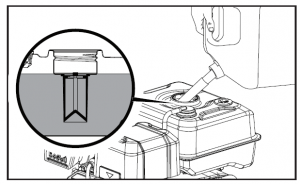


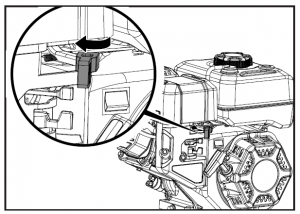
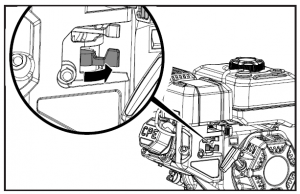

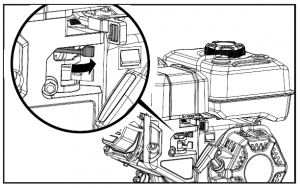 NOTICEIf the engine starts but does not run make certain that the log splitter is on a flat, level surface. The engine is equipped with a low oil sensor that will prevent the engine from running when the oil level falls below a critical threshold.
NOTICEIf the engine starts but does not run make certain that the log splitter is on a flat, level surface. The engine is equipped with a low oil sensor that will prevent the engine from running when the oil level falls below a critical threshold.


